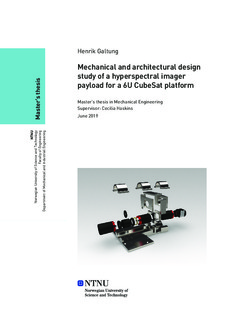Mekanisk og arkitektonisk designstudie av en hyperspektral nyttelast for en 6U CubeSat platform
Master thesis
Permanent lenke
http://hdl.handle.net/11250/2623214Utgivelsesdato
2019Metadata
Vis full innførselSamlinger
Sammendrag
Arbeidet som presenteres i denne oppgaven viser utviklingen av et hyperspektral kamera ogtilhørende nyttelaster ombord på en CubeSat eid av HYPSO-prosjektet. Avhandlingen fungerersom et cover for en pakke med tekniske rapporter skrevet i prosjektperioden. Disse rapportenegir en detaljert beskrivelse av design, testing og analyse som ble gjort for å utvikle nyttelastene.Designet av HSI var en fortsettelse av designarbeidet fra prof. Fred Sigernes og designarbeidetutført av mekanikkteamet for deres spesialiseringsrapport. En termisk og mekanisk analyse bleutført av HSIen, og resultatene var innenfor operasjonskravene. En prototype av HSI blemaskinert i aluminium og deretter kjørt en funksjonalitetstest på. Resultatene var positive, ogprototypen ga et skarpt spektrogram med god definerte spektral-linjer. Gjennom testing har detvist seg at COTS-komponentene i HSIen har uønskede egenskaper og materialer, spesielt nårdet gjelder utgassing. Forebyggende strategier er forelagt for disse problematiske faktorene.Oppsettet innenfor satellittbusen ble bestemt gjennom en kombinasjon av en arkitektoniskanalyse og de etablerte nyttelastkravene. Plasseringen for hver komponent ble bestemt sammenmed deres orientering og mekaniske grensesnitt. Mekanikkteamet utviklet også en preliminærdempeløsning og layout i samarbeid med det franske selskapet SMAC. Denne løsningen erfortsatt et forslag, men det fungerer som et fundament for fremtidig arbeid. Det ble ogsåutviklet en tilpasset grensesnittløsning for SDR da det var begrenset plass i busen, og standardstacking rings levert av NanoAvionics kunne ikke brukes i den ønskede plasseringen.Denne masteroppgaven vil også avdekke flere forbedringspunkter og identifisereinteresseområder for fremtidig arbeid. The work presented in this thesis shows the development of a hyperspectral imager and theassociated payloads on-board a CubeSat owned by the HYPSO project. The thesis serves as acover for a package of technical reports written during the research period. These reportsprovide a highly detailed description of the design, testing, and analyses done to develop thepayloads.The design of the HSI was a continuation of the prototype design from Prof. Fred Sigernes andthe design work done by the mechanics team for their specialization report. Both a thermal andmechanical analysis was performed on the HSI, and the results were within the operationalrequirements. A prototype of the HSI was machined in aluminium and put through afunctionality test. The results were positive, and the prototype produced a sharp spectrogramwith distinct spectral lines. Through testing it has been shown that the COTS components in theHSI features undesirable properties and materials, especially in terms of outgassing. Mitgationstrategies were proposed for these problematic factors.The layout inside the satellite bus was determined through a combination of a architecturalanalysis and the established payload requirements. The locations for each component was setalong with their orientation and mechanical interfaces. The mechanics team also developed apreliminary damping solution and layout in cooperation with the french company SMAC. Thissolution is still a work in progress, but a foundation has been laid. There was also developed acustom interface solution for the SDR as there was a limited amount of space inside the bus, andthe standard stacking rings supplied by NanoAvionics could not be used at the desired location.The presented material will also uncover several points of improvement and identify the areas ofinterest for future work.
